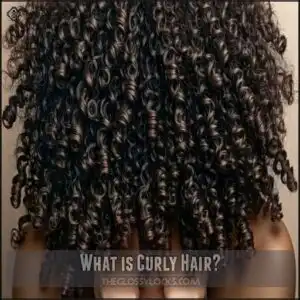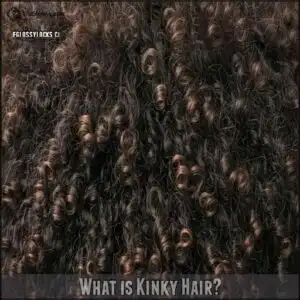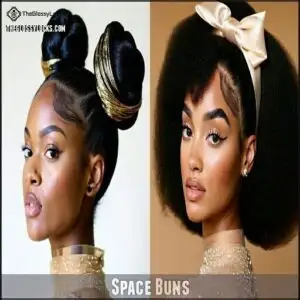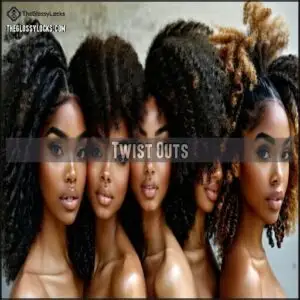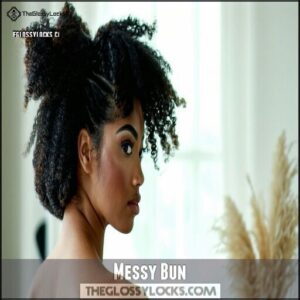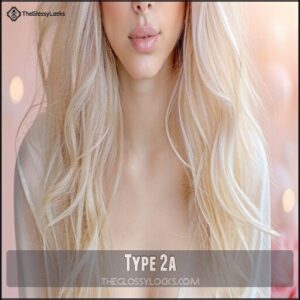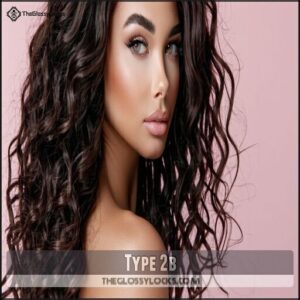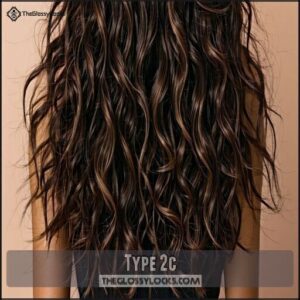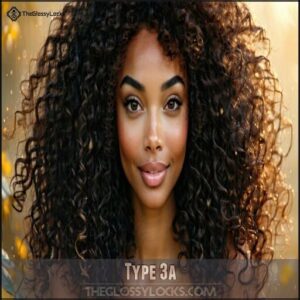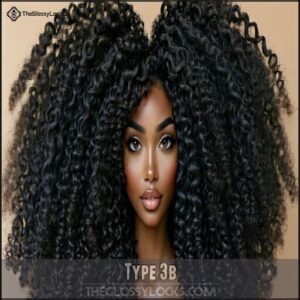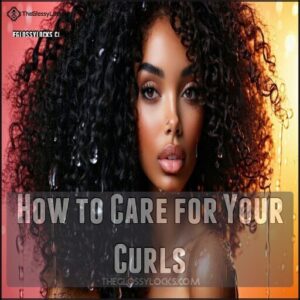This site is supported by our readers. We may earn a commission, at no cost to you, if you purchase through links.
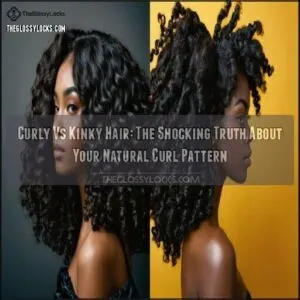
You’ll notice curly hair tends to stretch more when pulled, while kinky hair shrinks substantially when dry.
Both require moisture, but kinky hair typically needs more hydration due to its structure making oil distribution challenging.
When styling, curly hair often responds well to lighter products, whereas kinky hair benefits from richer butters and creams.
Understanding your specific pattern isn’t just about appearance—it’s the key to selecting the right care routine that will transform your relationship with your natural texture.
Table Of Contents
- Key Takeaways
- What is Curly Hair?
- What is Kinky Hair?
- Curly Vs. Kinky Hairstyles
- The 9 Types of Curls
- How to Care for Your Curls
- Frequently Asked Questions (FAQs)
- Is my hair kinky or curly?
- Is it coiled or kinky hair?
- What makes hair kinky and curly?
- What is the difference between curly and kinky hair?
- What is the best way to style curly and kinky hair?
- How to prevent damage to curly and kinky hair?
- What is the Andre Walker Hair Typing System?
- What is the difference between 4A, 4B and 4C kinky hair?
- Can curly hair become kinky over time?
- How often should kinky hair be washed?
- Conclusion
Key Takeaways
- You’ll recognize curly hair by its S-shaped spiral patterns, while kinky hair forms tighter Z-shaped coils with more volume and density.
- Your hair’s porosity affects moisture retention—kinky hair typically needs richer butters and creams, while curly hair responds better to lighter products.
- You can style both hair types with options like space buns, twist outs, and messy buns, but each requires specific techniques to highlight your natural pattern while preventing breakage.
- You’ll need to prioritize moisture for both types, but with different approaches—apply products to soaking wet hair, use protective styling, and adopt gentle detangling techniques specific to your curl pattern.
What is Curly Hair?
Curly hair is defined by its distinctive spiral patterns that form "S" shaped loops around themselves.
Unlike straight hair, these defining spirals create natural volume but face unique moisture challenges.
Defining spirals naturally boost volume but demand extra care to conquer the unique moisture challenges curly hair faces.
Your curl definition depends on hair porosity, which affects how well products penetrate the strand. Curly hair tends to be drier than other hair types since oils struggle to travel down the twisting hair shaft.
This hair texture requires specific product selection focused on hydration and definition. Understanding your curl pattern—whether loose waves or tight ringlets—helps determine the right moisture needs for healthy, bouncy curls.
What is Kinky Hair?
While curly hair features defined spiral patterns, kinky hair takes texture to another level.
Distinguished by its tight Z-shaped coils and distinctive "Z" pattern formation, kinky hair (classified as type 4 hair) has a unique structure that creates impressive volume but challenges moisture retention.
I’ll create a short, engaging blockquote that captures the essence of that paragraph about kinky hair in the same tone:
Type 4 hair’s magnificent Z-coils create stunning volume while demanding moisture devotion to truly thrive.
Your kinky texture naturally has high hair porosity, allowing moisture to enter quickly but escape just as fast.
This hair type’s sharp angles contribute to its hair fragility, making protective styling essential.
The coil pattern often appears compressed, with significant shrinkage that can hide your hair’s true length.
One way to combat this is through consistent deep conditioning treatments.
Don’t worry about dryness—with proper hydration techniques, your kinky hair will thrive beautifully.
Curly Vs. Kinky Hairstyles
You’ll find different styles work best depending on whether you have curly Type 3 hair with its defined "S" patterns or kinky Type 4 hair with its tighter "Z" coils.
Popular options like space buns, twist outs, and messy buns can be adapted to either texture, but each requires specific techniques to highlight your natural pattern while preventing breakage, which is crucial for maintaining healthy hair.
Space Buns
Space buns offer a playful way to showcase your natural texture while protecting delicate strands.
This versatile style works beautifully for both curl patterns. For a lasting style, consider setting with hairspray.
| Hair Type | Styling Tips | Products | Time Needed | Benefits |
|---|---|---|---|---|
| Curly | Smooth with wide-tooth comb | Curl cream | 10-15 minutes | Defines curls |
| Kinky | Section carefully | Butter-based moisturizer | 15-20 minutes | Prevents breakage |
| 3A-3C | Use medium tension | Lightweight gel | Varies by length | Showcases pattern |
| 4A-4C | Stretch gently | Edge control | Varies by thickness | Reduces shrinkage |
| All Types | Secure with satin scrunchies | Anti-frizz serum | Add 5 mins for decorating | Protects ends |
The table provides styling tips for different hair types, including Curly, Kinky, 3A-3C, 4A-4C, and All Types, highlighting the importance of using the right products and techniques to achieve the desired look and benefits.
Twist Outs
While space buns give you a playful look, twist outs are your ticket to defined curls that last for days.
This versatile style works wonderfully on both curly and kinky hair textures. Notably, kinks show vulnerability and may require extra care.
| Hair Type | Twist Out Technique | Products Needed | Maintenance Time |
|---|---|---|---|
| 3A-3C | Chunky twists | Curl cream | 3-5 days |
| 4A | Medium twists | Butter + oil | 5-7 days |
| 4B | Small twists | Heavy cream | 7-10 days |
| 4C | Mini twists | Butter + gel | 10-14 days |
For best results, apply products to soaking wet hair and let twists dry completely before unraveling.
Messy Bun
When chaos meets style, the messy bun becomes your curl’s best friend.
This versatile updo works wonderfully for both curly and kinky hair types while protecting your natural texture.
| Messy Bun Tips | Curly Hair | Kinky Hair |
|---|---|---|
| Preparation | Apply leave-in conditioner | Use thick moisturizing cream |
| Detangling | Wide-tooth comb while wet | Finger detangle in sections |
| Gathering | Loose ponytail at crown | Gentler tension to prevent breakage |
| Securing | Wrap around hair tie | Use bobby pins for extra hold |
| Finishing | Pull out face-framing tendrils | Leave edges natural or apply edge control |
To create your perfect messy bun, start with damp hair and apply products while your curls are still wet.
Gently gather your hair at the crown, wrap it around loosely, and secure with bobby pins rather than elastic bands to prevent breakage.
You can find specialized hair accessories crafted to complement the style.
Don’t worry about perfection – the messier, the better!
This approach allows for a more natural, effortless look that enhances your curl’s best friend, the messy bun, making it a great style for both curly and kinky hair types.
The 9 Types of Curls
You’ll discover your unique curl pattern among the nine distinct types ranging from subtle waves to tight coils on the hair typing system.
Understanding your specific curl type helps you choose the right products and techniques for your natural hair texture.
Type 2a
If you’re wondering about Type 2a hair, it’s characterized by fine waves that are closer to straight hair but with a gentle, subtle wave pattern.
This hair type responds well to minimal product application and simple styling techniques.
When caring for Type 2a curly hair:
- Apply lightweight mousse or defining cream to damp hair to enhance your natural wave pattern without weighing it down
- Try sea salt spray for added texture and volume boost without causing damage
- Avoid heavy oils or butters that can flatten your fine waves and make them appear limp
Your hair texture classification matters for product selection. Type 2a typically benefits from volumizing formulas that won’t overwhelm your delicate wave pattern. With proper care, you’ll maintain those beautiful, natural waves while preventing damage.
To help maintain hair health, schedule regular trims every 8-10 weeks, which is crucial for preventing damage and keeping your hair looking its best with proper care.
Type 2b
Identifying Type 2b hair reveals a distinct S-shaped wave pattern that sits between loose waves and defined curls.
Your 2b hair texture typically has more volume at the roots while maintaining definition along the strands.
| 2b Characteristics | Styling Needs | Care Tips |
|---|---|---|
| Defined S-shaped waves | Light-weight products | Regular moisture treatments |
| Medium texture | Mousse or light gel | Avoid heavy oils |
| Volume at roots | Sea salt spray enhances waves | Weekly deep conditioning |
| Prone to light frizz | Best styled when damp | Use microfiber towels |
| More defined than 2a | Diffusing helps definition | Sleep with protective styling |
Unlike its 2a counterpart, Type 2b hair holds shape better throughout the day but isn’t as defined as 2c waves. To maintain your wave pattern, use products specifically formulated for wavy hair types that won’t weigh down your natural texture.
Consider using specialized mousse products for ideal results, and remember that regular moisture treatments and weekly deep conditioning are crucial for maintaining healthy and defined waves. Using light-weight products and avoiding heavy oils can also help preserve the natural texture of your hair. Additionally, diffusing helps definition and can enhance the overall appearance of your 2b hair. By following these tips and using the right products, you can keep your natural texture looking its best.
Type 2c
While 2b waves show defined S-patterns, Type 2c hair sits at the curlier end of the wave spectrum, often mistaken for true curls.
Your 2c hair features the tightest wave pattern with pronounced volume and definition that borders on curly territory.
Caring for 2c hair texture requires:
- Lightweight moisture that won’t weigh down your waves
- Defining creams or light gels to enhance your natural pattern
- Sea salt spray for added texture when styling on damp hair
The 2c hair type in the hair classification system needs balanced maintenance—enough moisture to fight frizz without overwhelming your waves.
To find the right products, consider exploring options for specific 2c hair.
With proper products, you’ll maximize your hair’s natural volume while maintaining those beautiful, defined patterns.
Type 3a
Three key characteristics define Type 3a hair: loose, bouncy curls that form an "S" pattern when dry.
Unlike 2c waves, 3a curls maintain their definition without styling. Your 3a curls need consistent moisture to prevent frizz while preserving their natural shine.
For styling, light products work best—try mousse or defining cream to enhance curl definition without weighing hair down.
When washing, use sulfate-free shampoos and follow with deep conditioning treatments weekly.
Many 3a curlies find success with the "scrunch and go" method that preserves the hair texture’s natural bounce, which is essential for maintaining natural shine.
Type 3b
Moving from looser curls to more definition, Type 3b hair features springy, well-defined curls that create beautiful ringlets. Your 3b curls have a distinctive corkscrew shape that’s more compact than 3a, resembling the size of a large marker.
Here’s what makes Type 3b hair special:
- More prone to frizz than 3a, especially in humid weather
- Often thick and coarse, requiring regular hydration
- Forms spiral patterns that create natural volume
- Needs anti-frizz products to maintain curl definition
- Benefits from moisturizing styling creams rather than lightweight products
When styling your 3b curls, you’ll want to focus on moisture-rich products that define without weighing down. Unlike 3a hair, your curls need heavier creams to tame frizz while enhancing your natural curl pattern. This approach helps to achieve beautiful ringlets and maintain curl definition, which is crucial for managing thick and coarse hair.
How to Care for Your Curls
Water is your curly hair’s best friend. Proper hydration forms the foundation of healthy curls and coils, whether they’re curly or kinky.
Here are 5 essential care tips for your natural hair:
- Hydration Methods: Apply moisture-boosting products while your hair is still soaking wet to lock in hydration.
- Protective Styling: Sleep with your hair in a loose "pineapple" on top of your head or try protective styles like space buns.
- Detangling Techniques: Don’t comb your hair post-shower; instead, scrunch curls while wet to help them define naturally.
- Product Selection: Avoid rough towels – use a cotton T-shirt or microfiber towel to gently blot hair dry.
- Scalp Health: Maintain a consistent washing schedule (typically twice weekly) and get regular trims for ideal hair health.
Consider using sulfate-free shampoo options to prevent moisture stripping.
Remember: don’t touch your curls while they’re drying to prevent unwanted frizz!
Frequently Asked Questions (FAQs)
Is my hair kinky or curly?
I’d need to see your hair to determine whether it’s kinky or curly.
Kinky hair features tight Z-shaped patterns, while curly hair has S-shaped spirals.
You can check your curl pattern when wet, and kinky hair is one type to look out for.
Is it coiled or kinky hair?
Without seeing your hair, I can’t determine if it’s coiled or kinky.
Coiled hair forms "O" shaped patterns while kinky hair has "Z" shaped patterns with sharp angles.
A close look will reveal which type, specifically by identifying the "O" or "Z" shaped patterns.
What makes hair kinky and curly?
Your hair bends, folds, and twists based on your follicle shape.
Curly hair forms spiral "S" patterns, while kinky hair creates tight "Z" angles.
Both types struggle with dryness due to oil distribution challenges.
What is the difference between curly and kinky hair?
Curly hair forms "S"-shaped spirals or ringlets.
Your kinky hair typically has more texture, volume, and shrinkage than curly hair does, while kinky hair creates tighter "Z"-shaped patterns with sharper angles.
What is the best way to style curly and kinky hair?
Imagine your crown of spirals dancing freely in the sunlight.
You’ll find twist-outs, protective styles, and moisture-sealing techniques work best.
Always use leave-in conditioner and define your natural pattern with gentle finger-coiling, using techniques that help moisture-sealing.
How to prevent damage to curly and kinky hair?
Protect your delicate strands by using sulfate-free products, deep conditioning weekly, detangling with a wide-tooth comb when wet, avoiding heat styling, and sleeping on a silk pillowcase to prevent friction.
What is the Andre Walker Hair Typing System?
You’d think hair typing would be simple, but Andre Walker’s system classifies your locks from Type 1 (straight) to Type 4 (kinky), with subcategories (A-C) based on curl pattern, size, and texture.
What is the difference between 4A, 4B and 4C kinky hair?
Looking at kinky hair types, your 4A has defined S-shaped coils.
4B features zigzag Z-shaped patterns with moderate shrinkage, while 4C has the tightest coils with up to 90% shrinkage and minimal definition when dry.
Can curly hair become kinky over time?
Like a chameleon adapting to its environment, your hair can’t truly change from curly to kinky.
Your natural curl pattern is genetically determined, though damage, hormones, and aging may temporarily alter its appearance.
How often should kinky hair be washed?
You should wash kinky hair every 7-10 days to prevent dryness. Your scalp needs cleaning, but overwashing strips natural oils. Use sulfate-free shampoo and always follow with a moisturizing conditioner.
Conclusion
Understanding the difference between curly vs kinky hair might seem overwhelming at first, but it’s actually quite simple once you know what to look for.
Whether you’re rocking S-shaped waves or Z-pattern coils, embracing your natural texture starts with the right knowledge and products.
You’ll find that working with your hair type—not against it—transforms frustrating styling sessions into enjoyable self-care moments.
Remember: your unique curl pattern isn’t just beautiful—it’s your signature look.
- https://www.healthline.com/nutrition/argan-oil
- https://en.wikipedia.org/wiki/SoMo_(album)
- https://www.carolsdaughter.com/blog/hair/hair-care-tips/kinky-hair-care-routine.html
- https://www.unice.com/blog/kinky-curly-vs-kinky-straight/?srsltid=AfmBOoq11PIiLd4-PLaGMDjVAadQjHmJnQ7DkuxmNILW8LI8wXTRJ5vi
- https://www.qvr.com/blogs/news/kinky-hair-vs-curly-hair-whats-the-difference?srsltid=AfmBOopT5GVKNQN6gyQGJ1pLO6cciTisDPV4sFazYmupGWdhgRyTJB9c

